Whirlpool art 419 g Handleiding
Whirlpool
Koelen vriezen
art 419 g
Bekijk gratis de handleiding van Whirlpool art 419 g (3 pagina’s), behorend tot de categorie Koelen vriezen. Deze gids werd als nuttig beoordeeld door 64 mensen en kreeg gemiddeld 4.1 sterren uit 32.5 reviews. Heb je een vraag over Whirlpool art 419 g of wil je andere gebruikers van dit product iets vragen? Stel een vraag
Pagina 1/3

English
28
GB
ELECTRICAL CONNECTION AND OPERATION
This appliance has been designed, built and marketed in
compliance with:
- the safety targets of the “Low Voltage” EEC Directive
72/23;
- the protection requirements of the “EMC” EEC Directive
89/336 amended by EEC Directive 93/68.
Check that the voltage on the rating plate, situated at the right
hand side of the crisper corresponds to the voltage in your home
(Fig. 6).
The earthing of this appliance is compulsory by law. The
manufacturer will accept no liability for injury to persons
or damage to objects arising from the non-observance of
this requirement.
If the plug and the wall socket do not comply, have the socket re-
placed by a qualified electrician.
He should also check that the section of the socket wires can
withstand the power absorbed by the appliance. The use of adap-
ters, multiple sockets and extension cords is not advisable.
If absolutely necessary, use simple or multiple adapters and exten-
son cords in compliance with local safety regulations, paying at-
tention not to exceed the maximum amperage, which is marked
on the simple adaptors and on extension cords and that of the
total power marked on the multiple adapters. With the appliance
plugged in, the interior light should come on when the refrigera-
tor door is opened, unless the thermostat control knob is set to ●
symbol.
Adjust the thermostat control knob as suggested in the next
chapter. The refrigerator is ready for use.
For Great Britain only:
ELECTRICAL INFORMATION
WARNING - THIS APPLIANCE MUST BE EARTHED
Fuse replacement
If the mains lead of this appliance is fitted with a BS 1363A 13
amp fused plug, to change a fuse in this type of plug use an
A.S.T.A. approved fuse to BS 1362 type and proceed as follows:
1. Remove the fuse cover (A) and
fuse (B)
2. Fit replacement 13A fuse into fu-
se cover
3. Refit both into plug.
IMPORTANT: The fuse cover must
be refitted when changing a fuse
and if the fuse cover is lost the plug
must not be used until a correct re-
placement is fitted.
Correct replacements are identified by the colour insert or the
colour embossed in words on the base of the plug.
Replacement fuse covers are available from your local electrical
store.
CONNECTION TO A REWIREABLE PLUG
If the fitted plug is not suitable for your socket outlet, then it
should be cut off and disposed of in order to avoid a possible
shock hazard should it be inserted into a 13A socket elsewhere.
A suitable alternative plug should then be fitted to the cable. The
wires in this mains lead are coloured in accordance with the fol-
lowing code:
BLUE "NEUTRAL" ("N")
BROWN "LIVE" ("L")
GREEN AND YELLOW "EARTH" ("E)
1. The GREEN AND YELLOW wire must be connected to the ter-
minal in the plug which is marked with the letter "E" or by the
Earth symbol or coloured green or green and yellow.
2. The BLUE wire must be connected to the terminal which is
marked with the letter "N" or coloured black.
3. The BROWN wire must be connected to the terminal which is
marked with the letter "L" or coloured red.
ENVIRONMENTAL HINTS
Packing
Do not throw the packing into the garbage: first sort out the dif-
ferent materials (i.e.: steel, cardboard, polystyrene) following local
regulations.
Conformity declaration
This appliance incorporates parts intended to come into contact
with foodstuffs in compliance with EEC Directive 89/109/CEE.
Information
This appliance is free of CFC’s (refrigerant circuit contains R134a) or
free of HFC’s (refrigerant circuit contains R600a - Isobutane).
For more details, please refer to the rating plate on the appliance.
For appliances with Isobutane (R600a)
The refrigerant Isobutane is a natural gas of high environmental
compatibility but which si inflammable. Therefore, it is essential
to ensure that the ducts of the refrigerant circuit do not get da-
maged.
KNOW YOUR APPLIANCE
The appliance you have just bought allows, dependent on mo-
dels, the storage of fresh foods and if it is equipped with the low
temperature compartment marked by a symbol , the free-
zing-in of small quantities of foods, the storage of commercially
frozen foods and the production of ice cubes.
The appliance fitted with super insulation have been designed to
grant high performances with a reduced energy consumption.
Please read these instructions carefully, you will find the descrip-
tion of your appliance and the useful hints to obtain the best
performance to store foods.
DESCRIPTION OF THE APPLIANCE (Fig. 1)
1) Temperature control knob of both compartments (thermostat)
2) Light switch
3) Low temperature compartment
4) Grids (adjustable in height)
5) Separator
6) Crispers
7) Inner door liner with racks
8) Butter and eggs compartment
INSTALLATION
Please ensure that the appliance is undamaged. Transit dam-ages
must be reported to your delaer within 24 h of receipt of the ap-
pliance. We suggest you wait 1 hour approx, before connecting
the appliance to the mains to allow the refrigerant circuit to be
effective. The appliance should not be installed close to heat
sources, central heating, cookers, boilers, sunlight, etc. It must
however be located in a well ventilated dry space.
If the appliance is installed under a kitchen furniture, leave a
50mm air gap (Fig. 2). Ensure that the appliance is level; adjust, if
required, the front foot (Fig. 3).
Fit the spacers (if provided) on the top of the condenser (Fig. 4).
To ensure free air circulation, ensure that the ventilation grid si-
tuated above the appliance is not obstructed (Fig. 5).
Clean the interior with a sponge dampened in a solution of warm
water and bicarbonate of soda or vinegar.
INSTALLATION OF THE APPLIANCE UNDER
A WORKTOP
This appliance can be installed under a worktop, situated at a di-
stance of 850 mm from the floor. Proceed as follows:
- Remove screws 9 and 10 (at the front and rear) and remove the
worktop of the appliance (Fig. 16).
- Cut a ventilation opening in the worktop (Fig. 17).
- Install the appliance under the worktop and fix it at the front by
means of the screws 10 previously removed from the worktop of
the appliance.
- Mantain the distance from the rear wall as shown (Fig. 17).
B
A

English
29
GB
For the Republic of Ireland only
The information given in respect of Great Britain will frequently
apply, but a third type of plug and socket is also used, the 2-pin,
side earth type. In this case, the wire which is coloured GREEN
AND YELLOW must be connected to the EARTH contact, and the
other two wires to the pins, irrespective of colour. The supply to
the socket must be fitted with a 16 amp fuse. With the appliance
plugged in, the interior light should come on when the door is
opened.After adjustment of the temperature, as indicated in the
next chapter, the refrigerator is ready for use.
ADJUSTMENT OF THE TEMPERATURE
The thermostat (see figure) controls the temperature inside the
appliance. Position ●means that the operation of the appliance
is interrupted (the interior light is off).
To obtain the best storage of foods, we suggest you adjust the
thermostat control knob to position 4. To obtain colder tempera-
tures in the compartment, set the thermostat control knob to the
higher settings. If the temperature in the compartment is too
cold, turn the thermostat control knob to the lower setting (posi-
tion 1).
Internal temperatures are affected by the location of the applian-
ce, the temperature of the surrounding air, the frequency of door
opening. The setting of the thermostat may have to be varied to
allow for these factors. Experience will help you
in finding the position best suited to your needs.
USE OF THE REFRIGERATOR COMPARTMENT
(Fig. 7)
The temperature inside the compartment differs depen-
dent on the section. The coldest section is immediately above the
glass separator and near the rear wall.
All items stored in the refrigerator compartment should be wrap-
ped in aluminium or plastic sheetings or kept in a cover-ed con-
tainer. This prevents food from becoming dry on the surface and
stops strong smells and flavours being passed from one food to
another.
The space inside the refrigerator may be organised moving the
grids dependent on you needs.
Different foods are best stored in the following positions:
Cooked foods, cheese: use the top grids.
Meat, fish, sausages, etc.: these should be stored above the
glass separator.
Fruits and vegetables: these should be stored in the crisper.
Beverages: use the rack of the refrigerator door.
Butter: store in the special compartment of the refrigerator door.
In some models it is possible to adjust the temperature of this
compartment by means of the slot provided; in position ● the
butter can be easily spread.
Canned food: once the can has been opened, transfer un-used
food into a non-metallic container.
CABLE CLAMP
YELLOW & GREEN E
BLUE N
Connection to a
typical 13 amp plug
BROWN L
Important: Do not place foodstuffs or containers so that they do
not allow free circulation of air, or against the rear wall.
Do not cover the grids with paper or plastic. Allow cooked food
to cool before storing in the refrigerator compartment.
USE OF THE LOW TEMPERATURE
COMPARTMENT (Fig. 7) (if provided)
Your low temperature compartment (marked )is for free-
zing-in small quantities of foods, producing ice cubes and storing
frozen foods.
FREEZING-IN
In the compartment the temperature of -18°C allows the
freezing-in of a maximum quantity of 1,5 kg of foods in 24 h
period.
During freezing-in, we suggest you turn the thermostat control
knob to position 2-3.
Wrap foods to be frozen in aluminium foils or polythene films
and label each packet indicating the type of food and the free-
zing-in date.
Please make sure that already frozen foods do not come in con-
tact with fresh foods to be frozen.
Do not store warm foods in the low temperature compartment.
Do not re-freeze thawed or partially thawed foods, but use
them up within 24 hours or re-freeze after cooking.
Do not store liquids in glass containers.
PRODUCTION OF ICE CUBES
3/4 fill the ice cube trays, and store in the low temperature com-
partment. If the tray sticks to the compartment, do not try to de-
tach it with sharp or cutting instruments, which could damage
the appliance, but use the handle of a spoon.
Attenion: Do not eat ice cubes or ice lollies immediately after
their removal from the low temperature compartment, as they
may cause cold burns.
STORAGE OF FROZEN FOODS
When buying commercially frozen foods, make sure that wrapper
or packets is intact. If it bulges or sags or has spots of moisture
on it, it may not have been kept cold enough and the contents
may have lost their original quality. When home, store commer-
cially frozen foods in the low temperature compartment ,
with the least possible delay, as any appreciable rise in tempera-
ture may alterate their freshness.
Store commercially frozen foods no longer than the packet in-
structions recommend.
THAWING
Hera are some basic suggestions:
Raw vegetables: do not thaw, put straight into boiling water
and cook as usually.
Meat (large cuts): thaw in the refrigerator compartment
without unwrapping them. Before cooking, leave at room tempe-
rature for some hours, or defrost using your microwave. Please
follow the Manufacturer's recommendations.
(small cuts): thaw at room temperature or cook directly.
Fish: thaw in the refrigerator compartment without unwrapping
or cook directly before being completely thawed.
Previously cooked foods: pre-heat in the oven without remo-
ving from its aluminium container.
Fruit: thaw in the refrigerator compartment.
DEFROSTING
- If your appliance is not provided with a compartment, de-
frosting is automatic. During the defrost cycle some water drop-
lets fall down the rear wall of the liner. The defrost water is
collected into a tray situated on the compressor casing, whe-
re it evaporates.
- If your appliance is provided with a compartment, to keep

English
30
GB
energy consumption low, we suggest you periodically scrape off
the ice from the walls. Never use poined or sharp objects.
We recommend you defrost the appliance once or twice a year,
when the layer of frost reaches a 3mm thickness (Fig. 8).
To defrost the appliance, operate as follows:
- Disconnect it from the mains supply (Fig. 9);
- Remove all foods from the compartment.
- Turn the thermostat control knob to position ●;
- Dry the defrost water with a sponge or with a cloth (Fig. 10).
At completion of defrosting, dry the compartment walls, connect
the appliance to the mains, turn the thermostat control knob as
indicated in chapter "Adjustment of the temperature".
For this model as well, the defrosting of the refrigerator
compartment is automatic.
Attention: A temperature rise of frozen foods during defrosting
may shorten their storage life.
MAINTENANCE AND CLEANING
A periodic and proper maintenance will ensure a longer life to
your appliance. When carrying out any cleaning operation or
intervention, always disconnect the appliance from the
mains supply.
Periodically clean the inside of the compartments with a solution
of lukewarm water and vinegar. Rinse and dry.
Never use abrasives or detergents.
Periodically clean the drain situated at the rear (Fig. 11) with the
tool provided.
Clean the door gasket with water and dry carefully. Avoid soil-
ing the door gasket with oil or grease, which could damage it.
Clean the outside of the appliance with a sponge dampened in
lukewarm water. Dry with a soft cloth.
Clean periodically the condenser (Fig. 12) with a vacuum-cleaner.
HINTS FOR HOLIDAYS
If you plan to be away for a long time: disconnect the ap-
pliance from the mains supply, empty and clean the inside.
Leave
the door open to prevent the appliance from smelling musty.
If you plan to be away for a short time: let the appliance ope-
rate normally.,To disconnect the appliance temporarily turn the
thermostat control knob to position ●.
HINTS FOR ENERGY SAVING
You can save enery when operating the appliance:
- Check the door gasket; level the appliance to ensure a correct
door closing.
- If the appliance is provided with a compartment, periodi-
cally clean it from excessive frost; defrost when the layer on the
walls reaches a 3mm thickness.
- Periodically clean the condenser.
- Open the door only when necessary. Close it as soon as you ha-
ve removed food.
- Do not overload the refrigerator: let air circulate freely inside it.
- Do not adjust the thermostat control knob to an excessive cold
position: you will waste energy.
- Ensure that the appliance is not installed near a heat source su-
ch as cookers, radiators, boilers or in direct sunlight.
SERVICE (Fig. 15)
The incorrect operation of the appliance is not always due to a
fault but it may also result from poor installation or usage.
To prevent unnecessary service calls for which you will be char-
ged, we suggest you consult this trouble-shooting guide.
1) The temperature in the compartments is not cold enou-
gh. Check that:
- the door is properly shut;
- the thermostat is in the correct position (see chapter
"Adjustment of the temperature");
- the appliance is not too close to a heat source;
- the condenser is clean (Fig. 12);
- the low temperature compartment is not covered with an exces-
sive layer of frost.
- the air flow is not restricted.
2) The interior temperature is too cold. Check that:
- the thermostat control knob is in the correct position;
3) The appliance is excessively noisy. Check that:
- the appliance is level;
4) The appliance does not work at all. Check that:
- the thermostat control knob is not set to position ●;
- there is not a power failure;
- the supply plug is making good contact with the supply socket;
- check the plug fuse by connecting another appliance to the
supply socket.
For Great Britain only:
Check the plug fuse (if fitted).
A 13 A fuse must be fitted. Try new fuse - check removable plugs
for loose connections and tighten if necessary. Loose connections
can cause overheating of the plug: where this has occurred, re-
place the plug.
- The supply cable is broken (See also Note).
5) The interior light does not work
See point 4. Unplug the appliance and remove the lamp cover,
with a screwdriver (Fig. 13) and check that the bulb is not loose -
tighten if necessary. To change the faulty bulb, proceed as above
and fit a replacement bulb of not more than 15 W rating (Fig.
14).
6) Water on the floor of the refrigerator compartment
Check that:
- the thermostat is correclty set;
- the defrost water drainage system is not blocked;
- the drain hole is not obstructed (see chapter "Maintenance")
(Fig. 11).
Note: When replacing a damaged supply cord, be sure the new
cord is correctly clamped.
If you have followed the above checks and your appliance still
does not work properly, get in touch with the Service division.
Addresses and telephone numbers can be found on the Service
Registration Card or Booklet.
State clearly what is wrong and the type and serial number of
your appliance, which are indicated on the rating plate (Fig. 6).
DOOR REVERSIBILITY
1) Remove the lower hinge
2) Remove the door
3) Remove the screw
4) Change the pin
5) Change the foot
6) Remove the handle
7) Change the bush
8) Mount the handle
9) Fit the plugs
10) Change the handle
11) Fit the plugs
12) Mount the door
13) Mount the lower hinge
REVERSIBILITY OF THE LOW TEMPERATU-
RE COMPARTMENT (Fig. A)
1) Open the door and remove the bottom hinge.
2) Take off the door.
3) Take off the catch and fit it on the right.
Take off the spring and fit it on the left.
4) Remove the top bushing and put it into its seat on the left.
5) Fit the door on (turned through 180°).
6) Fit the bottom hinge back on.
7) Plug the unused hole with the clip (from the bag).
REVERSIBILITY OF THE LOW TEMPERATU-
RE COMPARTMENT (Fig. B)
1) Remove the left door block (2 screws).
2) Remove the hinges at the right hand side (4 screws and remo-
ve the door).
3) Remount the hinges at the left and side, remounting the door.
4) Remount the door block at the right hand side.
5) Plug the holes which remain unused with the 2 clips (from the
accessory bag).
A
B
Product specificaties
| Merk: | Whirlpool |
| Categorie: | Koelen vriezen |
| Model: | art 419 g |
Heb je hulp nodig?
Als je hulp nodig hebt met Whirlpool art 419 g stel dan hieronder een vraag en andere gebruikers zullen je antwoorden
Handleiding Koelen vriezen Whirlpool

7 Juni 2022

2 Mei 2022

19 Juni 2022

28 April 2022

2 Juni 2022

11 Juni 2022

7 Mei 2022

2 Juni 2022

20 Juni 2022

30 April 2022
Handleiding Koelen vriezen
- Friac
- Gastro-Cool
- Klarstein
- Liebherr
- Hollandia
- Siemens
- Dunavox
- Primo
- V-Zug
- Nordfrost
- MaxxHome
- Fagor
- ProfiCook
- Telefunken
- Rocktrail
Nieuwste handleidingen voor Koelen vriezen

5 Juli 2024

10 Juni 2024

10 Juni 2024

5 Juni 2024
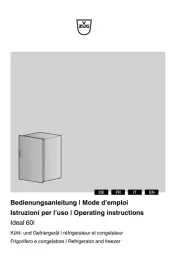
27 April 2024

22 April 2024
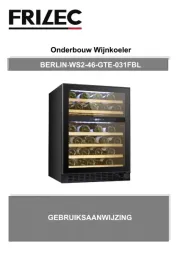
23 Februari 2024
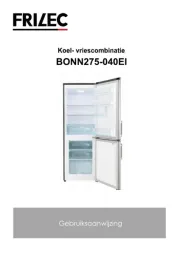
23 Februari 2024
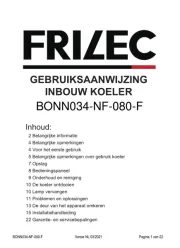
23 Februari 2024
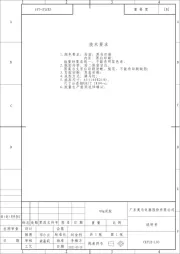
23 Februari 2024